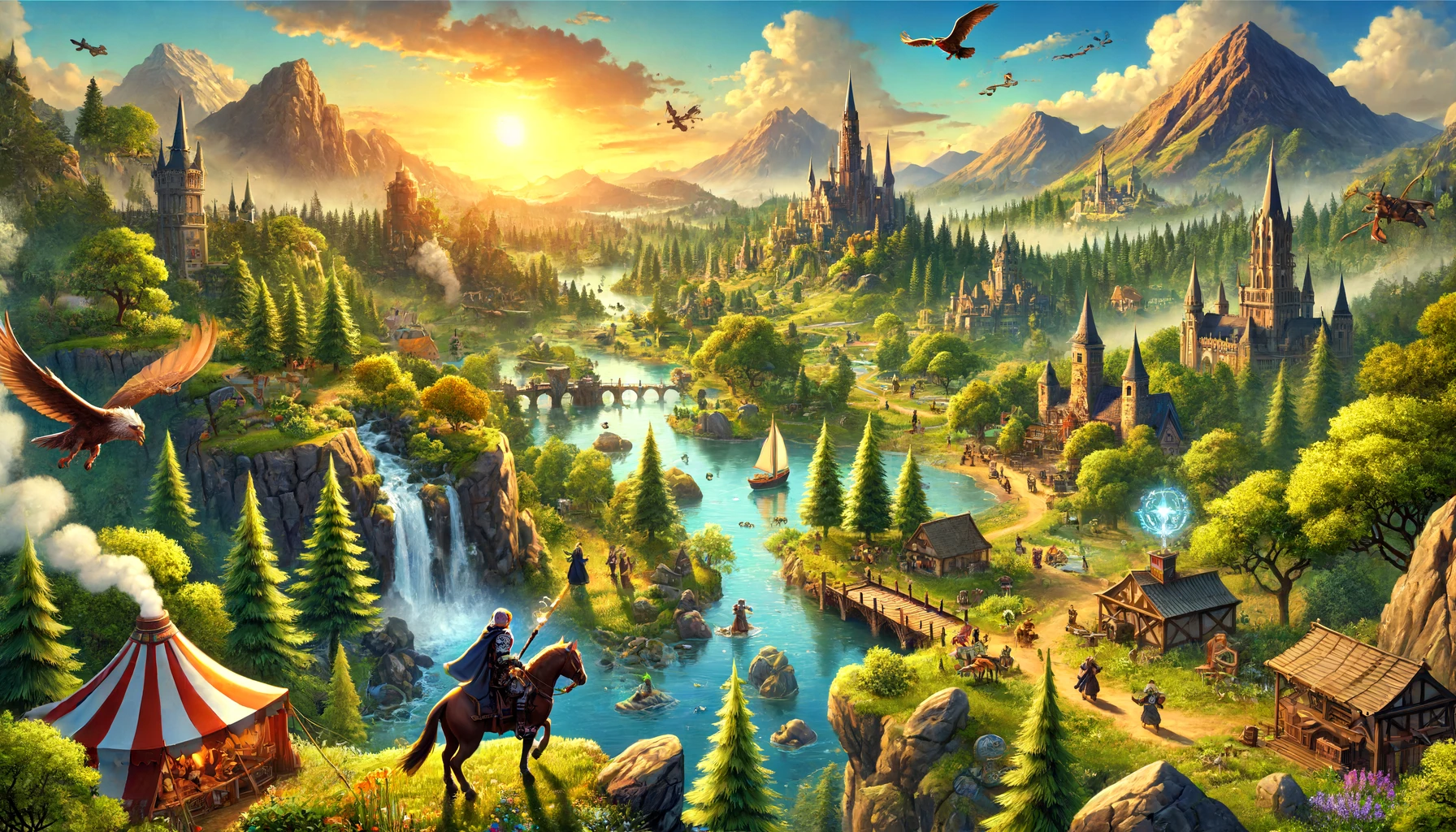Welcome, fellow adventurers, to the vast and exhilarating realm of open-world adventure games! At Aqueduct Entertainment, we’re passionate about gaming, and today, we’re diving deep into the open-world genre, where freedom, exploration, and immersive storytelling reign supreme. Whether you’re a seasoned gamer or just starting your journey, this blog post will guide you through the captivating world of open-world adventure games.
What are Open-World Adventure Games?
Open-world adventure games offer players an expansive, interactive environment to explore at their own pace. Unlike linear games, which follow a set path, open-world games allow for freedom and choice. Players can wander through richly detailed landscapes, undertake various quests, and interact with a myriad of characters.
Features of Open-World Adventure Games
To understand what makes open-world adventure games so captivating, let’s look at their key features:
- Expansive Worlds: These games feature large, detailed maps with diverse environments, from bustling cities to untamed wilderness.
- Freedom of Exploration: Players can explore the game world freely, often with few restrictions.
- Dynamic Quests and Storylines: Missions and quests can be approached in multiple ways, often with different outcomes based on player choices.
- Immersive Environments: High-quality graphics, sound design, and attention to detail create a realistic and engaging world.
- Character Development: Players can customize their characters, improving skills and abilities through gameplay.
Popular Open-World Adventure Games
Now that we’ve covered the basics let’s explore some of the most popular open-world adventure games that have captivated gamers around the globe.
The Legend of Zelda: Breath of the Wild
Released in 2017, Breath of the Wild redefined the open-world genre with its stunning graphics, intricate puzzles, and expansive world. Players assume the role of Link, exploring the kingdom of Hyrule to defeat the evil Calamity Ganon. The game is praised for its freedom, allowing players to approach challenges and quests in countless ways.
The Witcher 3: Wild Hunt
The Witcher 3 is a masterclass in storytelling and world-building. As Geralt of Rivia, a monster hunter, players traverse a beautifully rendered medieval world filled with intriguing characters, political intrigue, and moral dilemmas. The game’s rich narrative and deep character interactions set a high standard for open-world adventure games.
Red Dead Redemption 2
Set in the late 1800s, Red Dead Redemption 2 immerses players in the life of Arthur Morgan, an outlaw in a rapidly changing world. The game’s attention to detail, from its lifelike environments to its complex characters, makes it a standout in the genre. Players can engage in a variety of activities, from hunting and fishing to robbing trains and helping strangers.
Assassin’s Creed Odyssey
Assassin’s Creed Odyssey takes players to ancient Greece, where they can explore historical cities, engage in epic battles, and uncover hidden secrets. The game combines historical accuracy with mythological elements, providing a rich and varied experience. The freedom to shape the protagonist’s story based on player choices adds depth and replayability.
The Evolution of Open-World Adventure Games
The journey of open-world adventure games from humble beginnings to their current form is nothing short of remarkable. Let’s take a trip down memory lane and see how this genre has evolved.
Early Beginnings
The concept of open-world games dates back to the 1980s with titles like Ultima and Elite. These early games provided a glimpse into the potential of open-world exploration, though limited by the technology of the time.
The 3D Revolution
The late 1990s and early 2000s saw significant advancements with games like Grand Theft Auto III and The Elder Scrolls III: Morrowind. These titles introduced fully 3D environments, offering unprecedented freedom and interactivity.
Modern Masterpieces
In the past decade, technological advancements have allowed for even more ambitious projects. Games like The Witcher 3 and Breath of the Wild have set new benchmarks for quality, depth, and immersion. Modern open-world games now feature realistic physics, dynamic weather systems, and complex AI, creating worlds that feel truly alive.
The Impact of Open-World Adventure Games
Open-world adventure games have not only entertained millions but have also had a profound impact on the gaming industry and beyond.
Influencing Game Design
Many of today’s most popular games draw inspiration from the open-world genre. Elements such as non-linear gameplay, side quests, and expansive maps have become staples in various genres, from RPGs to shooters.
Cultural Impact
These games often tackle complex themes and tell stories that resonate with players. Titles like Red Dead Redemption 2 and The Last of Us Part II have sparked discussions about morality, society, and human nature, demonstrating the power of video games as a storytelling medium.
Technological Advancements
The development of open-world games has pushed the boundaries of what’s possible in gaming technology. Innovations in graphics, AI, and procedural generation have not only enhanced gaming experiences but have also influenced other industries, such as simulation and virtual reality.
Tips for New Players
If you’re new to the world of open-world adventure games, here are some tips to help you get started:
- Take Your Time: Don’t rush through the main storyline. Take the time to explore, engage in side quests, and soak in the game world.
- Experiment: Try different approaches to challenges and missions. The freedom to experiment is one of the genre’s greatest strengths.
- Pay Attention to Details: Look for environmental clues, listen to NPCs, and read in-game documents. These details can enhance your understanding of the story and the world.
- Customize Your Experience: Use the game’s customization options to tailor your character and gameplay style to your preferences.
- Join the Community: Engage with other players online. Forums, social media groups, and fan sites are great places to share tips, discuss strategies, and stay updated on game news.
Future of Open-World Adventure Games
As technology continues to advance, the future of open-world adventure games looks incredibly promising. Here are some trends to watch for:
Increased Realism
With the advent of next-gen consoles and powerful PCs, we can expect even more realistic graphics, physics, and AI. Games will continue to blur the line between virtual and real worlds.
Enhanced Interactivity
Future games will likely offer even more ways to interact with the environment and NPCs. Imagine a world where every object can be manipulated, and every character has a unique personality and backstory.
Procedural Generation
The procedurally generated content will become more sophisticated, allowing for virtually limitless exploration. Games like No Man’s Sky have already shown the potential of this technology, and future titles will build on this foundation.
Virtual Reality Integration
As VR technology improves, open-world adventure games will become even more immersive. Imagine stepping into a fully realized virtual world where you can explore, interact, and experience adventures firsthand.
Conclusion
Open-world adventure games offer a unique blend of exploration, storytelling, and interactivity that continues to captivate players around the world. From the vast landscapes of Breath of the Wild to the gritty realism of Red Dead Redemption 2, these games provide endless opportunities for adventure and discovery. Whether you’re a veteran gamer or new to the genre, there’s always something new to explore in the ever-expanding world of open-world adventure games.
Thank you for joining us on this journey through the world of open-world adventure games. At Aqueduct Entertainment, we believe in the power of gaming to inspire, entertain, and connect people. Stay tuned for more insights, reviews, and tips from the world of gaming. Happy adventuring!






